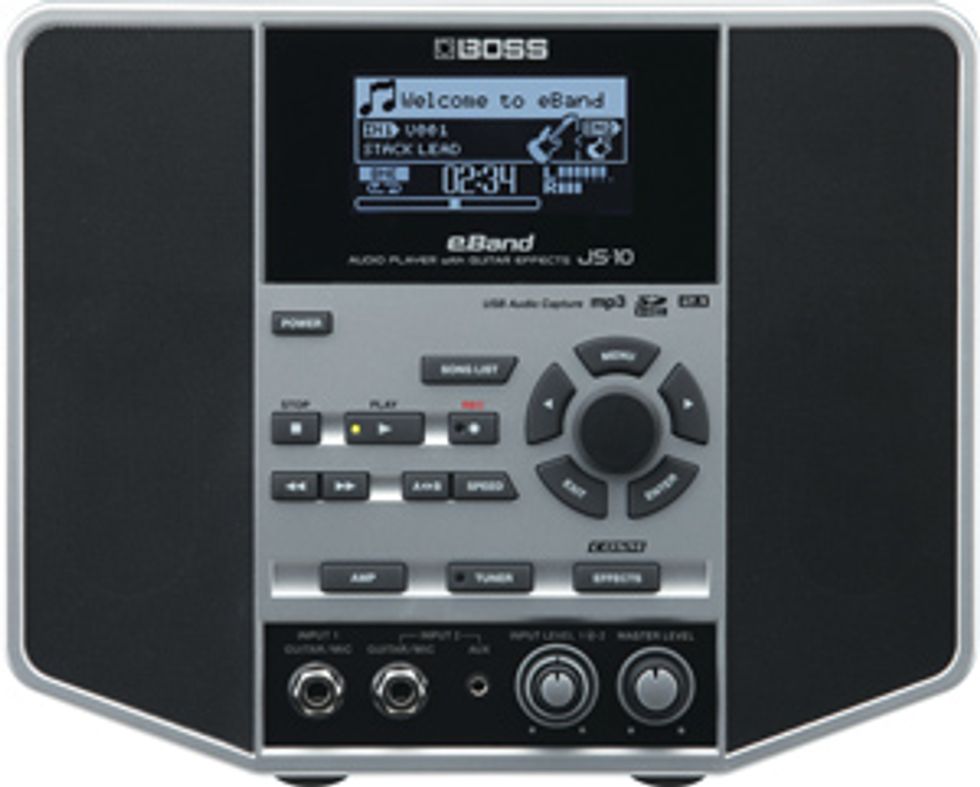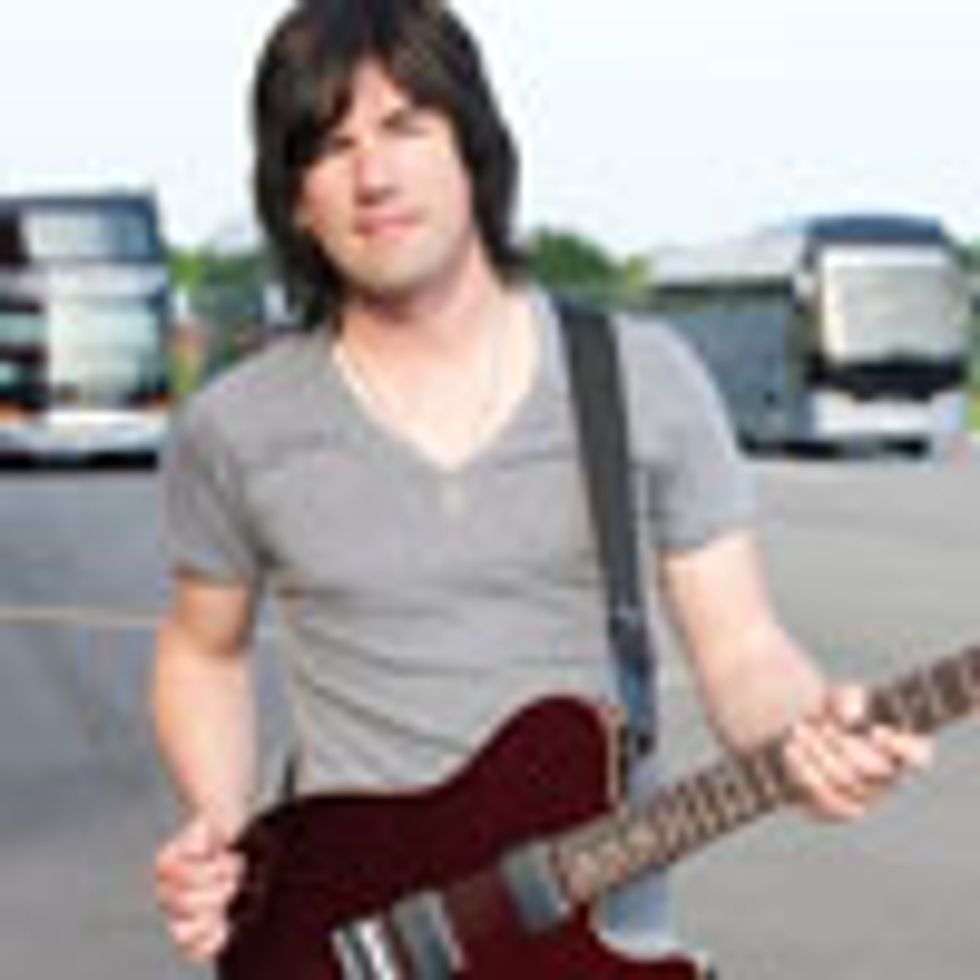
Compact yet loaded with effects, amp modeling, built-in speakers and much more, the eBand JS-10 from Roland is an ultra-portable practice station.
Remember the ’80s? I’m talking about crazy parties and limos, huge stadium tours, refrigerator racks, and 100-watt stacks. Rock ’n’ roll excess! But it’s 2013 now, and though gigs today require that you cover the same ground guitarists did back then, there’s a catch. Budgets are smaller than they used to be, and you are expected to do more— sometimes much more—for (and with) less. Fortunately, we guitarists have some amazing tools available these days to help us get killer guitar tones, without having to haul excessive amounts of gear to sessions and gigs. In this month’s column, I’m going to talk about some favorite musical tools that make my life a bit easier. Each one of these pieces of gear packs a huge range of tone and features into a compact package, ultimately allowing a guitarist to cover more ground with less.
Why Simplify?
I recently did some gigs with a well-known
pop singer, and their camp had gotten used
to touring with a very small crew consisting
of just a front-of-house engineer, monitor
engineer, and one tech. The tech was basically
focused on the artist—leaving the rest of the
5-piece band to fend for themselves—and
that’s how they’d always done it. We were playing
some fairly big venues, including the first
gig of the tour in an arena for about 6,000
people. Some of you might be wondering why
there weren’t more techs at that level. In my
experience, once an artist gets used to touring
a particular way, they just don’t want to spend
the money on more crew—no matter how
successful they become. Younger musicians
seem to be okay with doing more work for less
dough, and most artists don’t want to pay to
ship huge rigs overseas. Moral of the story: In
order to compete, it’s important for touring
sidemen to learn to be mostly self-sufficient.
Modeling Guitars
Let’s say you have a gig where you need a ton
of different sounds at your fingertips. How
do you cover nylon-string sounds, 6- and
12-string acoustic sounds, Strat, Tele, and
humbucker tones in various tunings—and
maybe even a sitar part—without hauling a
bunch of guitars to the gig? Go and check out
a guitar that uses modeling technology. The
VG Stratocaster from Fender and Roland is
a great choice because it will do everything a
standard Strat will do, as well as provide
all the aforementioned sounds, and
more. It’s an incredible tool that beats
lugging 10 guitars around, and I’ve used
mine for various gigs and sessions. The
Variax series of guitars from Line 6 is
another option worth checking out.
Dual Pedals
I have a few pedalboards, and my smallest
one is no slouch. I use it for sessions
and gigs where portability is a must, so
I chose pedals that would provide maximum
tone and versatility. There are a
number of manufacturers producing pedals
that do more than one thing—which I call
“dual” pedals—and they usually have two
footswitches, allowing a player to access the
different effects individually. I keep four of
these pedals on my little, yet extremely powerful,
pedalboard: a Strymon Flint for reverb
and tremolo, a Suhr Koko Boost for clean and
mid boost, a JHS Sweet Tea for distortion,
a TS-808-style overdrive, and a Red Witch
Medusa for chorus and tremolo.
Amp Modelers
Amp modeling is nothing new, but it’s
come so far in recent times. With advancements
such as profiling (the technology
used for the Kemper Profiling Amplifier)
and tone matching (used for the Fractal
Audio Axe-Fx II), guitarists can now
essentially duplicate the tone of any amp,
speaker, or mic chain, and then store it as a
preset to carry it wherever they go.
The Kemper Profiling Amplifier is a curious- and modern-looking device that’s about the size of a lunchbox, while the Axe-Fx II is a more traditional 2-rackspace unit. The Kemper has a basic selection of effects, but its forte is in profiling and storing the tones of amps and cabs with uncanny detail and realism. The Axe-Fx II has a full complement of effects that can be routed in any conceivable fashion, and with the amp and cabinet modeling enabled, you can replace an entire amp and effects rig. By disabling the amp and cabinet modeling, the Axe-Fx II also functions nicely as a full-featured effects processor that can be used with traditional guitar amps.
Be it for direct recording or playing live, there are some die-hards that still scoff at the idea of using units like these. But modeling has really gotten to the point where even tubeamp purists have to stand up and take notice. Globe-trotting guitarist Dweezil Zappa has totally replaced his amp rig and two refrigerator- sized racks with a pair of Axe-Fx IIs, saving untold thousands in shipping costs. Likewise, I left my traditional rigs at home for a couple of European tours with Melissa Etheridge, and used the Axe-Fx by running it direct to the PA.
A Portable Practice Solution
Plugging into an amp to practice isn’t always
practical in, say, a cramped dressing room
or the back lounge of a bus. The best solution
I’ve found (and currently my favorite
piece of gear) is the Roland eBand JS-10.
With built-in speakers, it’s a totally self-contained
audio player that also boasts amp
modeling and effects. It has 350 pre-loaded
audio loops and drum grooves for you to
jam along with, but you can easily add your
own audio files for playback, too. I’ve been
running my laptop into it with great results.
It’s just a killer, portable, simple all-in-one
practice solution, and it sounds fantastic.
Now more than ever, modern guitarists have incredible variety of powerful and portable tools for the studio, stage, and practice room to choose from. I said it last month and I’ll say it again: It’s never been a better time to be a guitarist!
 Pete Thorn is an L.A.-based guitarist, currently touring with Melissa Etheridge. His solo album Guitar Nerd is available through iTunes and cdbaby.com.You can read more about his career and music at peterthorn.com.
Pete Thorn is an L.A.-based guitarist, currently touring with Melissa Etheridge. His solo album Guitar Nerd is available through iTunes and cdbaby.com.You can read more about his career and music at peterthorn.com.





![Rig Rundown: Russian Circles’ Mike Sullivan [2025]](https://www.premierguitar.com/media-library/youtube.jpg?id=62303631&width=1245&height=700&quality=70&coordinates=0%2C0%2C0%2C0)

















